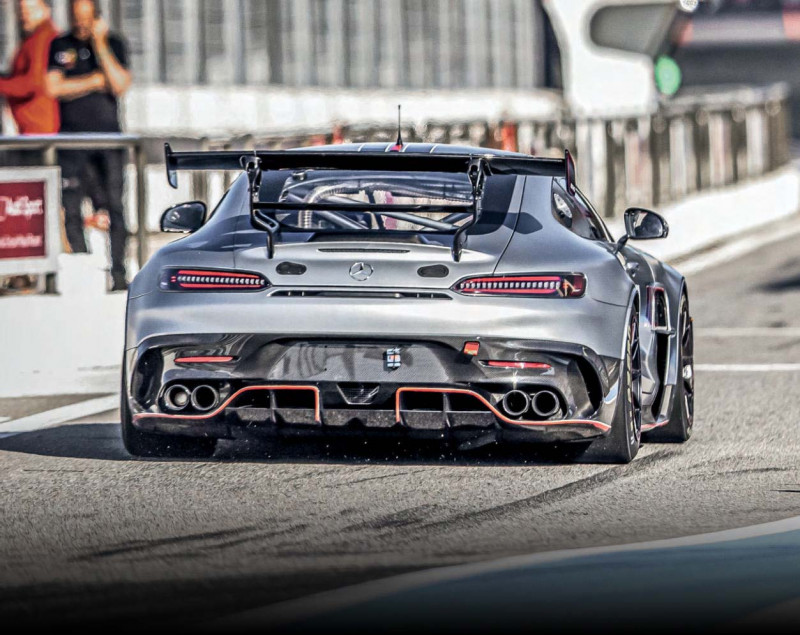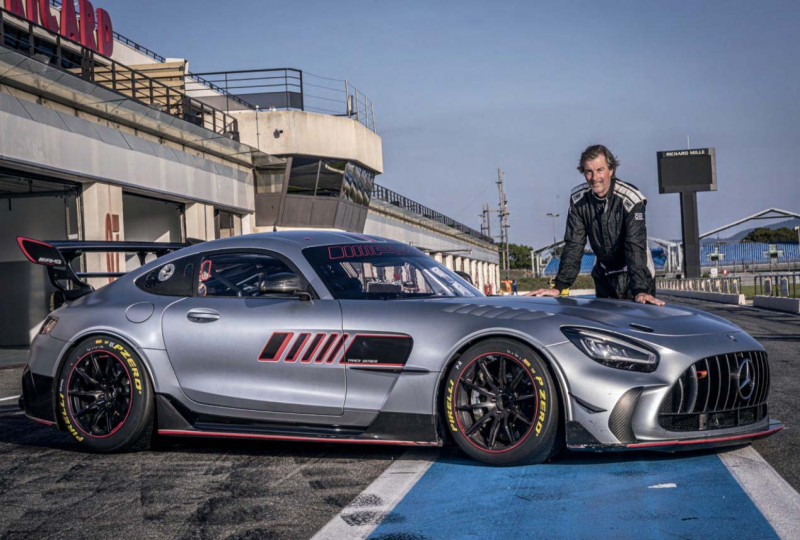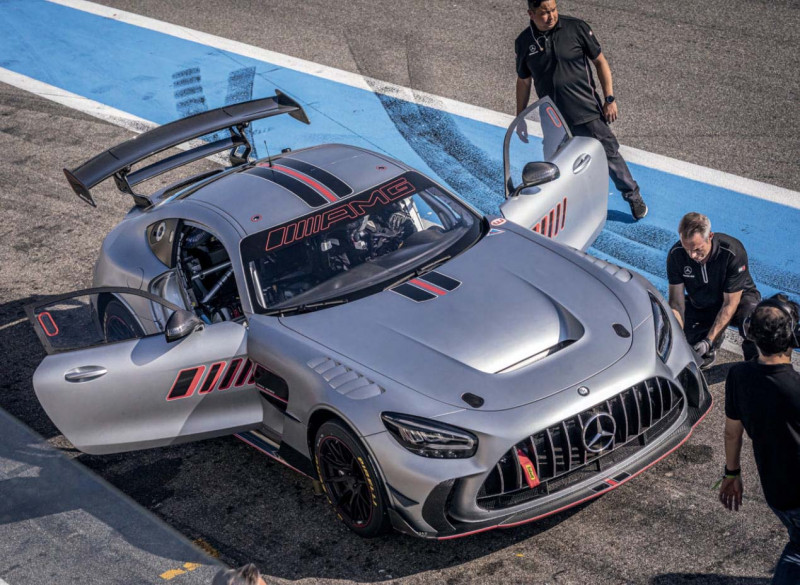2023 Mercedes-AMG GT Track Series C190
Mercedes-AMG builds a track toy that’s quicker than a GT3 car in a straight line, and lets us loose. Praise be.
BLACK TO TRACK
I see lights in the mirror, looming fast. I keep right through the sweeping Courbe du Garlaban right hander, all the way to entry of the Virage du Lac, a looping left. Two-time Bathurst 12-Hour winner Jules Gounon doesn’t need a second invitation: There’s a flash of silver and a growling bark as his Mercedes-AMG GT Track Series dives past under brakes. Gounon goes deep, then pivots left, using power to rotate the car and get to the left side of the track for the fast-approaching second-gear right hander leading on to the start-finish straight.

I watch the tail of the silver Mercedes glide as Pirelli slicks paint two fat black lines on the tarmac. Jules Gounon looks like he’s enjoying his job.
I WATCH THE TAIL OF THE MERCEDES GLIDE AS PIRELLI SLICKS PAINT TWO FAT BLACK LINES ON THE TARMAC
Gounon is honing the final chassis setup of the Track Series, the ultimate track-day car for the gentleman driver who has everything. Built by Mercedes-AMG Motorsport, the Track Series pulls together hardware from the roadgoing Mercedes-AMG GT Black series and the Mercedes- AMG GT3 and GT4 race cars to create the nearest thing to a Bathurst-winning Mercedes you can drive without a competition licence. And that’s not marketing hype: by the end of our session at Circuit Paul Ricard, Gounon had run a lap in the Track Series that was quicker than his best time there in the GT3.

Horsepower helps. FIA regulations restrict the GT3’s 6.2-liter naturally aspirated V8 to about 404kW and 650Nm in baseline tune. The dry-sump, flat-plane crank 4.0-liter twin-turbo V8 in the GT Track Series – the same engine that powers the road-going GT Black Series – punches out a thundering 540kW and 850Nm. The GT3 has a homologated base weight of 1285kg. The Track Series tips the scales at 1400kg. You don’t need to be a maths genius to figure out what’s going on here.
THE TRACK SERIES CLANKS AND BANGS AND WHINES AND WHIRRS DOWN PIT LANE, AN ANGRY BEAST RATTLING ITS CAGE
You could call the GT Track Series is a parts bin car. But when your bin has parts like AMG’s that’s hardly a criticism. The road-going GT Black Series engine has been given motorsport fuel injectors and revised engine mapping to boost power by 3kW and torque by 50Nm. It’s bolted, by way of a carbon fibre torque tube, to the six-speed, sequential-shift Hewland transaxle transmission used in the GT3 and GT4 race cars and is cradled by the light and extremely rigid aluminum spaceframe chassis from the GT4.

Like the Black Series and the GT3 and GT4 race cars, many of the Track Series’ body panels are carbon fibre. The bonnet and front fascia look very similar to those on the GT3 but are significantly different in detail; the high downforce front splitter has been developed specifically for the Track Series. The giant adjustable wing at the rear of the car is based on the Black Series wing but has been reworked to deliver increased downforce.
THE FLAT-PLANE CRANK TWIN-TURBO V8 STAMPEDES TO 7000RPM, A MENACING METALLIC EDGE TO THE WALL OF SOUND FILLING THE COCKPIT
The multi-link suspension features race-spec four-way adjustable Bilstein dampers that have high- and low-speed settings in both compression and rebound, and are height adjustable, too. As on the GT Black Series, the front and rear camber settings and front and rear stabilizer bars are manually adjustable. But instead of the carbon-ceramic brakes used on the Black Series, the Track Series is fitted with the 390mm front, and 355mm rear, steel rotor setup used on the GT3 and GT4 race cars, complete with a balance bar to adjust front to rear brake bias.

The Black Series rolls on 19-inch diameter front and 20-inch diameter rear lightweight forged alloy wheels, shod with Michelin Pilot Sport Cup 2 R tyres. The Track Series has 18-inch forged alloys all round, like the race cars, which means it can be fitted with a wide range of racing rubber. Other technologies lifted from the GT3 and GT4 race cars include the dry-break fuel filler and fuel cell, and the race-spec traction control and anti-lock brake systems, each of which is independently adjustable across 12 settings, with 1 offering the most intervention and 12 none.
IT’S SERIOUSLY FAST, BUT ALSO BENIGN ENOUGH NOT TO SCARE YOU SILLY AS YOU APPROACH THE LIMITS. YOURS, OR THE CAR’S
I’ve driven both the GT3 and GT4 racers, so the Track Series feels instantly familiar once I’ve contorted my frame through the FIA-spec high-tensile steel roll cage and into the driver’s seat.
Like both the race cars, the Track Series has been designed to accommodate drivers of all shapes and sizes – Mercedes-AMG Motorsport understands many of the well-heeled gentlemen drivers who buy its cars don’t have the snake hips and trim physiques of pro racing drivers. A small lever next to the centre console allows the spring-loaded pedal-box to move back and forth, and the butterfly steering wheel is height and reach adjustable.
The steering wheel, designed exclusively for the Track Series by SIM racing experts Cube Controls, is peppered with 13 buttons, the most important of which – for me – is the one that shifts the transmission to neutral, and the pit lane speed limiter. The dash comprises a fully programmable Bosch DDU 11 display unit that offers two different display modes and will show lap times recorded by the on-board data logging system.
On the centre console are the ignition switch, a pushbutton to select reverse, the on-board fire extinguisher switch, even an exterior mirror adjustment button. What will get the most use though is the knobs that control the traction control and ABS settings.

Jules Gounon gives me the pre-drive briefing. The car has been set up with the suspension on the soft side, and with mild understeer. Journo mode, in other words. No such constraints under the bonnet, though: The engine map has been set at 3, maximum power. Though he’s currently running with settings in the 8 to 10 range, Gounon advises me to keep the traction control and ABS at 6, mid-way points he says will allow the car to move around a bit under power and won’t set the brake pedal juddering at every corner but will still provide a solid safety net. That’s good by me.
We’ll be using the full F1 track at Circuit Paul Ricard, minus the chicane mid-way along the Mistral Straight. Gounon’s car is hitting its 320km/h maximum speed before the entry to the chicane. My car is slightly lower geared – its top speed is 300km/h – but that still means a long, fast run down to Signes, the sweeping right hander that is one of the most epic corners in grand prix racing. In today’s F1 cars, Signes is taken flat in top gear, a 340km/h slingshot ride. In the Track Series it’s a fifth gear corner. The trick to Signes, Gounon says, is to work up to staying off the brakes until the 200m board. Brake hard – you’ll need at least 100 bar of pressure on the pedal, he adds – then come off the pedal smoothly and get on the throttle early, feathering it to keep the car balanced as you sweep down to Beaussett, a tricky, double apex right hander. Sounds easy. In theory.
The flat-plane crank V8 fires up with an angry growl. Dip the clutch, snick the right paddle. There’s a hiss-clunk as the Hewland’s pneumatic actuator rams first gear into place. Revs, slip the clutch, more revs. The Track Series clanks and bangs and whines and whirrs down pit lane, an angry beast rattling its cage. Gounon leads me around for a couple of laps before heading into the pits for fresh tires and restarting his test program.
The flat-plane crank twin-turbo V8 stampedes to 7000rpm, a menacing metallic edge to the wall of sound filling the cockpit, and the Hewland tranny bangs off clutchless, full-power upshifts with such rapidity there’s scarcely a pause in the searing surge of acceleration. The brakes might be steel, but they feel utterly unquenchable, hauling the Mercedes down with calm authority. No matter how hard I grenade the pedal, I can easily modulate the pressure and keep away from the ABS threshold. Fanning the left paddle produces rapid fire downshifts like a short burst from a .50cal machine gun.
Despite all the sound and fury it doesn’t take long to start to get the measure of the Track Series. This is a Mercedes aimed at drivers who don’t want to spend the time and money on a GT4 or GT3 race program, but still want a properly sorted, professionally developed track car. And it absolutely nails its mission. It’s seriously fast – more than fast enough to have you fully engaged behind that butterfly steering wheel – but also benign enough not to scare you silly as you approach the limits. Yours, or the car’s.
In its relatively soft, journo-friendly setup, the Track Series telegraphs its punches with such clarity that even a non-race driver unused to slicks can easily sense what’s going on where the rubber meets the road, at both ends of the car. Trail braking into the tighter corners keeps the front end loaded so the slicks can bite and get you into the apex. And I can feel the weight transfer to the rear axle as I go to power, the backend hunkering down as the car punches out of the corner.
Signes? Yeah, it’s intimidating at first, but I did what Gounon told me, and trusted the car to do the rest. And it worked. I had more trouble trying to get through the double apex de Beaussett corner immediately afterward. It wasn’t the fast fourth-gear first apex that was the problem; it was trying to get the car turned for the tighter second. Gounon told me afterwards he downshifts to third between the two to get the front end to bite harder and uses power to rotate the car.
Compared with the GT3 race car, which generates more than twice the aerodynamic grip at 200km/h, the Track Series rolls more and is much more pitch sensitive. The attitude of the car under braking and cornering and acceleration, and how that affects the load on each tyre, determines its balance and grip levels. Understanding this is the key to unlocking a good lap time.
It’s also what makes the Track Series a hugely involving driver’s car. The same dynamic dance is going on in the Mercedes-AMG GT but the transitions are all so much quicker, so much more intense, that unless you’ve spent a lot of time behind the wheel of one it’s difficult to detect when you’re at the edge of the envelope. Other than in high-speed corners the Track Series is damn near as fast as the GT3, but the clarity of the dialogue between tyre and tarmac makes its limits much more approachable. You can feel what’s going on and adjust accordingly.
Just 55 Mercedes-AMG GT Track Series cars will be built, celebrating the founding of AMG by Hans Werner Aufrecht and Erhard Melcher 55 years ago. Base price ex-factory is the equivalent of $550,000 plus tax.
No, it’s not cheap, though air conditioning is standard (a basic spare parts set, seat and helmet ventilation system, a drink system, and full-race seat and safety cell for a brave passenger are among the available options). But what all that money also buys you is the Mercedes-AMG Motorsport service and technical support given to owners of the GT3 and GT4 race cars, including detailed technical training, race engineer support, and spare parts supply. That, combined with remarkable ease with which it allows you to explore its staggering performance, makes the Mercedes-AMG GT Track Series the best track day car in the world right now. At any price.
THE HOMOLOGATIONAMG DIDN’T ASK FOR
Track Series earns GT2 pass
Stephane ratel is a man that people don’t tend to say no to. So, when Mercedes- AMG said it wasn’t going to get the Track Series homologated for Ratel’s GT2 category, the boss of global GT racing got creative. You see, GT2 is Ratel’s pet project, and he himself races in the category. In Ratel’s, and many onlookers’, eyes, the Track Series was a perfect fit of GT2. Despite AMG’s repeated statements that this was a track day toy and nothing more, Ratel gifted the car a special homologation for GT2, just so he could race the car personally. With Bernd Schneider as his teammate, the SRO head honcho gave the Track Series the competitive debut it was never intended to have. The AMG competed against GT2 race cars from the likes of KTM, Audi, Porsche, and Brabham. Expect owners to follow suit.
RIGHT Jules Gounon is a back-to-back Bathurst 12 Hour winner. Angus is a back-to-back Gin Gin pie eating champion.
FAR RIGHT Turning up to a track day with a full fleet of mechanics and AMG’s most powerful car is a real millionare flex.
BELOW It’s not as complex as Lewis Hamilton’s tiller, but the wheel still requires attunement
ABOVE While the Track Series uses the GT3 racer’s chassis, it ditches the bonkers aero to be more approachable for gentleman drivers
LEFT The current GT3- spec GT uses the old SLS’s 6.2-litre atmo. Expect its replacement to use this twin-turbo M178
FAR RIGHT Track Series owners will need to source their own tooth picks for removing beaten Porsches from the grille after a track day
BELOW RIGHT Fuel cell takes 120 litres of the good juice, which is consumed quicker than Bob Hawke sculling a beer
The Specs GT2 RS who?
- CAR MERCEDES-AMG GT TRACK SERIES C190
- BODY 2-door, 2-seat coupe
- DRIVE rear-wheel
- ENGINE 3982cc V8, DOHC, 32v, twin-turbo
- BORE X STROKE 83.0 x 92.0mm
- COMPRESSION 10.5:1
- MAX POWER 580kW @ 6700-6900rpm
- MAX TORQUE 850Nm @ 2000-6000rpm
- POWER/WEIGHT 414kW/tonne
- TRANSMISSION six-speed sequential
- WEIGHT 1400kg
- SUSPENSION Double wishbone, coilovers, manually adjustable dampers, anti-roll (f/r)
- L/W/H 4551/2007/1284mm
- WHEELBASE 2630mm
- TRACKS 1720/1680mm (f/r)
- STEERING electro-mechanical power assist rack-and-pinion
- BRAKES 390mm ventilated carbon-ceramic discs, 6-piston calipers (f); 355mm ventilated carbon-ceramic discs, 4-piston calipers ®
- WHEELS 18 x 12.0-inch (f); 18 x 13.0-inch ®
- TYRES 325/660/18 (f); 325/705/18 Pirelli P Zero slicks
- PRICE $542,000
- PROS Massive power; race-ready; communicative
- CONS Where do we put the number plates?
- STAR RATING 4/5


